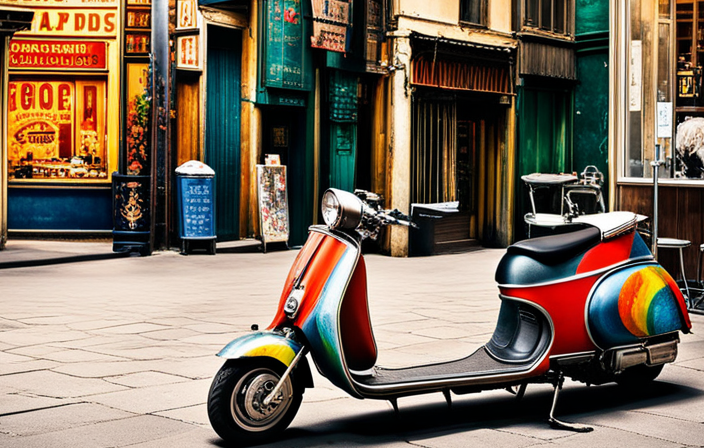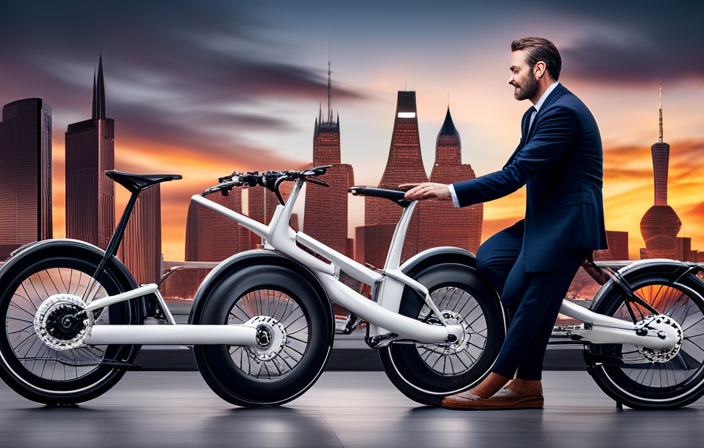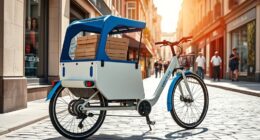Wondering about the differences between electric bikes and electric mopeds? Let’s explore the contrasts and uncover the specifics.
From speed and power to licensing requirements, battery life, and environmental impact, there’s plenty to explore.
In this informative article, we’ll compare these two modes of transportation, considering factors like practicality, ease of use, and safety.
By the end, you’ll have a clearer understanding of which option suits your needs best.
So, saddle up and prepare for an electrifying ride through the world of e-bikes and e-mopeds.
Key Takeaways
- Electric bikes are lighter and easier to maneuver, while electric mopeds provide more power and are suitable for longer distances and higher speeds.
- Electric bikes have lower maximum speeds compared to electric mopeds, which can reach speeds of up to 30 mph or more.
- Electric mopeds have larger and more powerful braking systems, providing better stopping power in emergency situations, while electric bikes have smaller and less powerful braking systems.
- Different helmet requirements may apply to electric bikes and electric mopeds, so it is important to familiarize yourself with local traffic regulations and ensure riding safely and legally.
Definition and Features of an Electric Bike
An electric bike, also known as an e-bike, is a bicycle equipped with an electric motor to assist with propulsion. The motor, powered by a rechargeable battery, provides an extra boost to the rider’s pedaling efforts. This allows for longer distances to be covered without getting as tired, as the motor assists with pedaling uphill or against strong winds. Additionally, electric bikes enable riders to reach higher speeds, making them suitable for commuting or recreational purposes.
However, there are some disadvantages to consider. Electric bikes tend to be heavier and more expensive than traditional bicycles. Furthermore, the battery may need to be recharged regularly.
Now, let’s move on to the definition and features of an electric moped.
Definition and Features of an Electric Moped
One way to distinguish between electric bikes and electric mopeds is by understanding their distinct characteristics and functionalities.
An electric moped, also known as an electric scooter, is a motorized vehicle that is designed for urban transportation. It typically has a step-through frame, a small engine, and a maximum speed of around 30 to 40 miles per hour. Electric mopeds are often used as an alternative to traditional gasoline-powered mopeds, offering advantages such as lower maintenance costs, zero emissions, and quieter operation. However, they also have some disadvantages, including limited range and slower speeds compared to electric bikes.
Transitioning into the subsequent section about speed and power comparison, it is important to note that electric bikes generally offer more speed and power than electric mopeds.
Speed and Power Comparison
When comparing speed and power, electric bikes generally offer more than electric mopeds. Electric bikes are designed to provide higher speeds and greater power compared to electric mopeds. This is mainly due to their lighter weight and more advanced motor technology. Electric bikes often have higher speed limitations and larger motor sizes, allowing them to reach higher speeds and handle steeper terrains more efficiently. To illustrate this comparison, consider the following table:
| Electric Bikes | Electric Mopeds | |
|---|---|---|
| Speed Limitations | Up to 28 mph | Up to 20 mph |
| Motor Size | 500-750 watts | 250-500 watts |
As you can see, electric bikes generally have a higher speed limitation and larger motor size, offering more speed and power. However, it’s important to note that specific models may vary in terms of speed and power capabilities. Moving on to the next section about licensing and legal requirements, it is essential to understand the regulations surrounding these vehicles.
Licensing and Legal Requirements
To legally operate either vehicle, you must be aware of the licensing and legal requirements. When it comes to electric bikes, the licensing requirements vary depending on the country or state you reside in. In some places, electric bikes with a maximum speed of 20 mph may not require a license, while others may require a driver’s license or a specific electric bike license.
On the other hand, electric mopeds typically require a driver’s license, registration, and insurance, just like traditional gasoline-powered mopeds. It’s important to check your local laws and regulations to ensure you meet all the licensing requirements and legal obligations for whichever vehicle you choose. Understanding these requirements will help you stay compliant with the law and avoid any potential penalties.
Moving on to battery life and range…
Battery Life and Range
If you want to maximize your riding time, it’s essential to consider the battery life and range of your chosen vehicle. Electric bikes and electric mopeds differ in terms of battery life and range.
Electric bikes generally have smaller batteries, which means they have a shorter range compared to electric mopeds. On average, an electric bike can travel around 20-50 miles on a single charge, depending on the terrain and rider’s weight. In contrast, electric mopeds can travel up to 60-100 miles on a single charge.
Additionally, charging time and maintenance costs should also be considered. Electric bikes usually have shorter charging times and lower maintenance costs compared to electric mopeds. These factors should be taken into account when deciding between an electric bike and an electric moped.
Moving on to the next section about ‘cost comparison’, it’s important to evaluate other financial aspects as well.
Cost Comparison
Comparing the costs of both options, it is important to consider factors such as initial price, maintenance, and charging expenses. When looking at the electric bike vs electric moped cost analysis, it becomes clear that there are some key differences.
For starters, the initial price of an electric moped is generally higher than that of an electric bike. This is because mopeds typically have more powerful motors and larger battery capacities. Additionally, the maintenance costs for a moped are usually higher due to the need for regular servicing and potential repairs.
On the other hand, electric bikes tend to have lower initial costs and require less maintenance. They also have the advantage of lower charging expenses, as their batteries are typically smaller and can be charged using a standard electrical outlet.
To further illustrate the cost comparison, let’s take a look at the table below:
| Factors | Electric Bike | Electric Moped |
|---|---|---|
| Initial price | Lower | Higher |
| Maintenance costs | Lower | Higher |
| Charging expenses | Lower | Higher |
Considering these factors, it is clear that electric bikes offer a more cost-effective option compared to electric mopeds. They not only have lower initial and maintenance costs, but also cheaper charging expenses. This makes electric bikes a practical and economical choice for many individuals.
Moving on to the next section about environmental impact, it is important to consider how these vehicles contribute to sustainability and reduce carbon emissions.
Environmental Impact
The environmental impact of these vehicles is an important consideration. Electric bikes and electric mopeds have a positive impact on the environment due to their use of renewable energy sources. Unlike traditional bikes and mopeds that rely on fossil fuels, electric bikes and mopeds are powered by electricity, which can be sourced from renewable energy such as wind or solar power. This significantly reduces their carbon footprint and helps to decrease air pollution and greenhouse gas emissions.
Additionally, electric bikes and mopeds are more energy-efficient compared to traditional vehicles, as they require less energy to operate. This makes them a greener transportation option, contributing to a cleaner and more sustainable environment.
Moving on to the next section about practicality and ease of use, electric bikes and mopeds offer convenient and efficient transportation solutions.
Practicality and Ease of Use
Convenient and easy to use, electric bikes and mopeds provide efficient transportation options. When comparing the practicality and ease of use between the two, electric bikes offer several advantages. First, they are more cost-effective than electric mopeds. With lower upfront costs and minimal maintenance requirements, electric bikes are a budget-friendly choice. Additionally, electric bikes are lighter and more maneuverable, making them easier to navigate through traffic or tight spaces. They also require less parking space and can be easily stored indoors. However, electric mopeds have their own benefits, such as higher speeds and longer range, which can be advantageous for longer commutes. Considering these factors, it is important to weigh the cost effectiveness and maintenance requirements when choosing between an electric bike and an electric moped. Moving on to safety considerations…
Safety Considerations
When it comes to safety, it’s important to consider factors such as speed, braking capabilities, and visibility. Both electric bikes and electric mopeds have their own safety considerations.
In terms of speed, electric mopeds tend to be faster than electric bikes, reaching speeds of up to 30 mph or more. This increased speed can require a higher level of skill and caution when riding.
Additionally, electric mopeds often have larger and more powerful braking systems, providing better stopping power in emergency situations.
In terms of visibility, both electric bikes and electric mopeds can benefit from using lights and reflective gear to increase visibility to other road users. Helmet requirements and traffic regulations also play a crucial role in ensuring safety.
Depending on your location, different helmet requirements may apply to electric bikes and electric mopeds. It’s important to familiarize yourself with local traffic regulations to ensure you are riding safely and legally.
Considering these safety factors, it’s crucial to choose the right option for your needs, taking into account your riding experience, comfort level, and intended use.
Choosing the Right Option for Your Needs
To choose the right option for your needs, consider factors such as your riding experience, comfort level, and intended use.
When it comes to electric bikes and electric mopeds, weight considerations and maintenance requirements are crucial factors. Electric bikes are generally lighter and easier to handle compared to electric mopeds. They are designed for shorter commutes and recreational rides. If you have limited riding experience or prefer a lighter option, an electric bike might be the better choice for you.
On the other hand, electric mopeds are heavier and provide more power, making them suitable for longer distances and higher speeds. However, they require more maintenance due to their complex mechanical components. So, if you prioritize power and plan to cover longer distances, an electric moped would be the more suitable option, but be prepared for more maintenance responsibilities.
Frequently Asked Questions
Are electric bikes and electric mopeds the same as regular bikes and mopeds, just with an electric motor added?
Yes, electric bikes and electric mopeds are similar to regular bikes and mopeds, but with the added advantage of an electric motor. Electric bikes offer benefits like pedal-assist and extended range, while electric mopeds provide advantages such as higher speeds and greater carrying capacity.
Can electric bikes and electric mopeds be used on the same bike lanes and roads as regular bicycles and mopeds?
Yes, electric bikes and electric mopeds can be used on the same bike lanes and roads as regular bicycles and mopeds, as long as they adhere to the specific electric bike regulations. Electric mopeds have the advantage of higher speeds and longer ranges compared to electric bikes.
How long does it take to charge the battery of an electric bike or electric moped?
Charging time for electric bikes and electric mopeds varies based on battery capacity. Typically, it takes around 4-6 hours to fully charge the battery of an electric bike or electric moped, allowing for a convenient and quick recharge.
Are there any restrictions on the use of electric bikes and electric mopeds in terms of age or physical fitness?
There are typically no age restrictions for using electric bikes or electric mopeds, but physical fitness may play a role. Electric bikes require minimal physical effort, while electric mopeds may require a valid driver’s license and physical capability to operate.
Do electric bikes and electric mopeds require regular maintenance like traditional bicycles and mopeds?
Regular maintenance is necessary for both electric bikes and electric mopeds. Just like traditional bicycles and mopeds, these vehicles require routine check-ups, such as battery maintenance, tire pressure checks, and brake adjustments, to ensure optimal performance and longevity.
Conclusion
After comparing the features, speed, licensing requirements, and practicality of electric bikes and electric mopeds, it is clear that these two modes of transportation have distinct differences.
While an electric bike offers convenience and eco-friendliness, an electric moped provides more power and speed.
The choice between the two ultimately depends on your needs and preferences. As the saying goes, ‘Different strokes for different folks.’
So, consider your lifestyle, commute distance, and legal requirements to make the right decision for a smooth and enjoyable ride.









